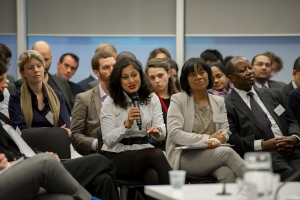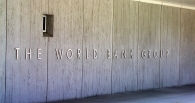A personal view of the ODI CAPE Conference 2015
Elizabeth Hodson
7 December 2015
/
- 1 Comments
This year the Centre for Aid and Public Expenditure (CAPE), based at the Overseas Development Institute (ODI) in London, chose for its annual conference topic “Investment in infrastructure”, or “Bricks and dollars”. Sessions covered a gamut of issues including why there is a renewed push for infrastructure, how to decide what to build, how to successfully implement plans, the effect of urbanisation, the role of the private sector, and financing. This ambitious and wide-ranging conference was full to overflowing with Ministers from sub Saharan Africa, government representatives from South America and Asia, academics, researchers, engineers, international development consultants like myself and even a former Prime Minister – Gordon Brown, speaking in his current role as Chair of the World Economic Forum’s Global Strategic Infrastructure Initiative.
The conference started strongly, with excellent introductory talks by ODI staff, and impressive keynote speakers in the form of a Minister from Ethiopia and another from Liberia. Throughout the conference one could not help but be impressed with the calibre of the speakers, the organisation of the conference including very smooth technical management, the imaginative use of infographics and the timeliness of the sessions and the breaks. One person I spoke to towards the end said it was the best conference on this subject he’d ever been to, and I’m guessing that as a post doc researcher on infrastructure he’s been to quite a few.
The last session, as is usual in these events, attempted to bring together all the diverse themes that had come up in the sessions and draw out salient points and next steps. However, the comments that both the panel and the audience made appeared curiously disparate and insubstantial. Was this merely conference fatigue, after two long days of talk and coffee, or was the topic simply too wide to admit of any summary? I think there were a few factors that contributed to this, so, rather than giving a session by session run down (which in any case you can find on the ODI website), I’d like to dig a little around the issues that made the closing session somewhat stilted and perhaps had wider implications beyond the conference and for the sector as a whole.
Elephants and other sources of contention
So let’s start at the beginning when H.E. Gyude Moore, Minister of Public Works, Liberia, with the aid of photos of vehicles stranded in the middle of muddy Liberian main roads in the rainy season, eloquently made the point that a basic level of infrastructure is necessary before you start considering investment cases. When trying to make the financial case for a road or other major piece of infrastructure, the internal returns generated sometimes do not add up – but that in itself is not enough to say that the project is a “White Elephant”.
Now, this was an excellent point, but it stood alone. What implications can be drawn from it? Is it merely about achieving a basic level of transport infrastructure, or are there greater concepts involved?
In fact, this is textbook public economics: a public good will tend to be undervalued unless you price in the externalities, i.e. the wider social benefits. It was understandable that a politician making this point to a mixed audience would not put it in these terms, but where you have such a conceptual framework in place then the example slots neatly into it and bolsters understanding of how these ideas work in practice.
In one of the breaks, a researcher I spoke to complained about the knowledge silos that occur in international development, whereby PFM people only talk to PFM people, and Aid Effectiveness people do likewise. The conference was admirable in the breadth of people who attended and who spoke, and in facilitating cross-sector conversation, but the downside to breadth is lack of depth. Without shared language and shared concepts you cannot go deep or, given this was about infrastructure, build tall.
Another factor at play was how one deals with topics off the agenda: the elephant in the room. This came up even in the first session on investment and infrastructure in sub Saharan Africa. In the Q&A, one woman asked about the role of the Chinese, a question which was received with apparent embarrassment. “China is not the only country investing…”, the chair muttered, and the question remained unanswered. As the conference went on, there was continued silence on China’s role. One speaker, a researcher, talked of sources of finance – international sovereign bonds, lending from the Chinese, public-private partnerships (PPPs) – and said that some saw China as a potential threat, but then dismissed it with “there is no evidence in the literature” for this.
Again, it was in the time between sessions, over coffee and over lunch, that this issue was discussed. Perhaps it was too controversial to discuss openly in a large forum with an unknown audience who stretched beyond the room (the entire event was filmed – does this make people more reticent?); or perhaps people felt it had already been discussed enough: Chinese investment into sub Saharan Africa after a decade of rapid growth appears to be slowing, even declining. Nevertheless, it was notable that the issue had been effectively sidelined.
A further area of controversy was firmly on the agenda: the role of the private sector. We enjoyed a range of speakers on this subject: academics, bankers, government officials and our own former Prime Minister talking up the importance of partnerships. Despite this, it is clear that the private sector is still viewed with suspicion, as “the dark side”, as one speaker laughingly put it.
This came through in the questions. While most of the speakers appeared to speak in favour of the private sector, there were challenges from the audience as to the transparency and cost efficiency of PPPs. However, to analyse the pricing schedule of an infrastructure PPP with its time horizon of 20+ years requires an Excel spreadsheet model and a suitable counterfactual, so, in a conference setting, all we can do is accept the assurances of a civil servant from Peru that the policy really works and is transparent, and be reassured by the private fund manager that if the cost of risk is taken into consideration PPPs really do offer good value for money.
Incentivising agents
In the final session, though I realised this only in retrospect, one thought came up which, if expanded, could be a unifying strand. One of the ODI team responsible for the conference noted the importance of considering the “incentives to investment” and the positive effect of having infrastructure embedded in the strategic growth plan.
Thinking about incentives more generally, the reason people are cautious when dealing with the private sector is that the incentive of a firm is, broadly, to make profit and improve its market share; thus when it is building infrastructure, or in fact doing anything for a government, it is important to make sure a firm is incentivised to act in the interests of the country, as far as the project goes, rather than pursue profit at all costs. There are ways of encouraging this; good contract design and independent monitoring were tools which were mentioned in the conference only in passing but are key.[1]
Similarly, when Chinese investment or Chinese firms build infrastructure across Africa, or “connect the world by bullet trains” as one attendee said joyfully, it would be naive to think they are doing this simply for the good of the world. What their own motivations are is a separate subject, but whether they are the answer to Africa’s investment gap, or whether they are a “potential threat”, would depend on these unexamined incentives and how they are handled.
In conclusion, this was an excellent conference with a good range of speakers. The conference revealed some of the key issues our sector is facing: our ambivalent attitude to private sector investment, the impact of China, and our curious inability to talk about these issues in a deeper, constructive manner using shared language. Honest analysis of incentives and the use of public economics or other conceptual frameworks may be helpful here, but, as the speakers concluded at the end of the conference, there is still much work to be done.
[1]An ODI paper plugged at the conference, “Why subsidise the private sector?” by Paddy Carter, contained the following apposite quotation from Kaushik Basu, World Bank Chief Economist: “This partnership between the private and public is however fraught with risks, because it is like bringing two very different animals inside the arena. If the design of incentives and boundaries of action are not well-specified [it] can be a disaster…”. Carter’s paper used the framework of public economics to give a nuanced and sometimes critical view of public sector subsidy of private sector investment, and it formed a good counterpart to the conference.




